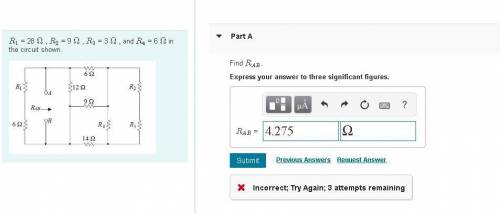
Engineering, 13.02.2022 05:10 CassidgTab
For these problems I feel like I am close but i don't quite fully understand them yet.
For calculating R_AB, I am not sure how the A and B terminals affect the whole circuit. Ive calculated the resistance of the circuit as a whole as if terminals A and B were not even there and calculated the resistance as if the resistances were in parallel from node A and node B. But i still get the wrong answer.
For the second question when calculating the solution for part B, I am also not sure how to calculate the resistance added by the ammeter. I know how to calculate the resistance of the shunt resistor though, how do i calculate how much resistance was added to the circuit. I calculate 50 ohms every time by dividing 150mV by 3mA.
Any help and direction is greatly appreciated



Answers: 3


Another question on Engineering

Engineering, 03.07.2019 15:10
Two flowing streams of argon gas are adiabatically mixed to form a single flow/stream. one stream is 1.5 kg/s at 400 kpa and 200 c while the second stream is 2kg/s at 500 kpa and 100 ? . it is stated that the exit state of the mixed single flow of argon gas is 150 c and 300 kpa. assuming there is no work output or input during the mixing process, does this process violate either the first or the second law or both? explain and state all your assumptions.
Answers: 1

Engineering, 04.07.2019 18:10
Acompressor receives the shaft work to decrease the pressure of the fluid. a)- true b)- false
Answers: 3

Engineering, 04.07.2019 18:10
An air conditioning system consist of a 5 cm diameter pipe, operating at a pressure of 200 kpa. the air initially enters the pipe at 15°c with a velocity of 20 m/s and relative humidity of 80%. if the heat supply throughout the process is 960 w, determine the relative humidity and the temperature at the outlet
Answers: 3

Engineering, 04.07.2019 18:10
Refrigerant 134a enters an insulated compressor operating at steady state as saturated vapor at -26°c with a volumetric flow rate of 0.18 m3/s. refrigerant exits at 9 bar, 70°c. changes in kinetic and potential energy from inlet to exit can be ignored. determine the volumetric flow rate at the exit, in m3/s, and the compressor power, in kw.
Answers: 1
You know the right answer?
For these problems I feel like I am close but i don't quite fully understand them yet.
For calcula...
Questions























